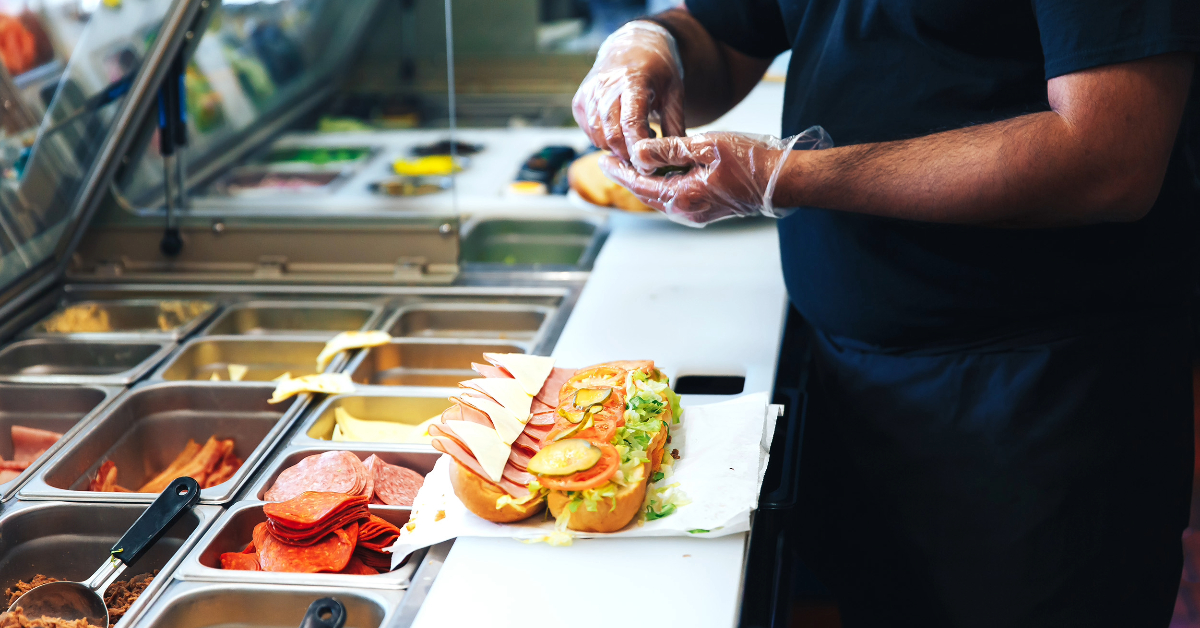
In the world of Retail Foodservice, there are several aspects managers and owners must contend with: staff turnover, service quality, profitability, and more. One area that often gets overlooked in the business of everyday operations, is food safety. Neglecting food safety can have disastrous consequences for your customers as well as your brand’s reputation.
Traditionally, one of the primary ways retail food service establishments (restaurants, hotels, commissaries, grocery stores, convenience stores, hospitals, ghost kitchens, etc.) aim to prevent, mitigate, or eliminate foodborne illness risks is to perform Hazard Analysis Critical Control Point (HACCP) based “Line Checks”. And now, thanks to digitization, applying the principles of HACCP as part of your Food Safety program has never been easier or more efficient.
Below, we’ll discuss the importance of line checks and why you should consider optimizing them by making the switch to digital.
Foodborne illnesses from restaurants
According to the CDC's Annual Report on the Surveillance for Foodborne Disease Outbreaks, there were 841 foodborne disease outbreaks in 2017 alone. This resulted in 14,481 illnesses, 827 hospitalizations, 20 deaths, and 14 food product recalls. The majority of outbreaks and illnesses were linked to facilities with localized food preparation. And among these, 64% of outbreaks and 44% of the associated illnesses were attributed to foods prepared in a restaurant, of which sit-down restaurants were most commonly reported. But why are retail foodservice establishments such a hotspot for food safety hazards? The CDC identified five risk factors that regularly contribute to foodborne illness outbreaks.
These included:
- Improper holding temperatures of potentially hazardous food (e.g., keeping foods at the potential danger zone
between41°F and 135°F); - Improper cooking temperatures of food (e.g., not cooking food long enough to reach minimum recommended temperature);
- Poor personal hygiene (e.g., food handlers neglect handwashing, etc.);
- Food from unsafe sources (e.g., food suppliers who don’t follow food safety guidelines);
- Contaminated utensils and equipment (e.g., contaminated utensils may transfer foodborne bacteria to cooked foods).
There are dozens of active control measures, handling practices, and sanitation methods that can be applied to inhibit or minimize these risk factors. Many of these measures, such as handwashing, have become standard in most facilities. That said, despite having knowledge of both the problem and the preventative actions, microbiological hazards have continued to plague the industry.
The importance of process HACCP to active managerial control
In most cases, this repeated failure can be chalked up to two things:
- A lack of solid Active Managerial Control (AMC) principles
- Failure to implement an effective Food Safety Management System (FSMS)
One of the most effective FSMSs designed for retail foodservice establishments to achieve Active Managerial Control (AMC) is called Process Hazard Analysis and Critical Control Points (HACCP). As described by the U.S. Food and Drug Administration (FDA), AMC can be achieved using an FSMS that employs specific actions or procedures to monitor and provide for immediate corrective actions of food safety hazards during retail operation.
HACCP is composed of 7 Principles, which identify biological, chemical, and physical hazards. These principles are addressed on a daily basis to ensure that the various processes (from food storage to preparation) are done properly and safely. The principles are:
- Conduct a hazard analysis
- Determine the critical control points (CCPs)
- Establish critical limits
- Establish monitoring procedures
- Establish corrective actions
- Establish verification procedures
- Establish record-keeping and documentation procedures
When the principles of HACCP are applied as intended, restaurants and other retail food service establishments serve food that is safer, more consistent, of higher quality, and better tasting. And, one of the primary ways by which this is done is by performing Line Checks for each meal period.
What are line checks?
In order to have an effective Food Safety Management System (FSMS), you need an operational execution plan with defined roles and responsibilities, as well as scheduled temperature and critical control point checks throughout the day. Doing so creates a “culture of operational excellence” and ensures the team maintains focus throughout the day.
Line Checks can be extensive forms and/or shorter checklists that help staff verify that the food products and equipment for the cooking line are adequately stocked, cleaned, or kept at the proper temperature. It’s an ongoing process that helps prepare each shift for the impending rush. Because when things get busy, problems tend to occur at a higher rate; workers pay less attention to the fine details, cut corners, or simply overlook potential problems.
As mentioned, these checks have to be regularly conducted throughout the day. In most cases there are five primary line checks that need to occur:
- Pre-AM shift – Approximately 30 minutes before the opening shift, to make sure that the day begins smoothly, and the food is properly stocked and ready. nbsp;
- Mid-morning check – After a few hours of operation, to confirm that both temperatures and quality haven’t been compromised.
- Pre-PM Shift – Approximately 30 minutes before the PM shift, to prepare the new shift members and ensure they have everything they need to maintain quality.
- Mid-afternoon check – After a few hours into the afternoon shift, to confirm once more that temperature and quality haven’t been compromised.
- Close – Once the day is done, to clean surfaces, utensils, and cooking items, toss out products that won’t be good the next day, and properly package and date food that can be stored.
While each line check is tailored to the specific environment, typically, there are several categories that must be evaluated in regard to food items, cooking equipment, and serving supplies. For example, there are five factors relating to food items:
- Temperature – Is the food cooked and stored at its ideal temperature?
- Freshness – When was the food prepared? Was it properly packaged and labeled with the date?
- Appearance – Does the food look aesthetically pleasing?
- Taste/Texture – Do the ingredients and the final product taste right (in terms of both flavor and texture)?
- Quantity – Are there enough ingredients to last another shift?
In addition to the examples mentioned above, there are several other elements that may need to be checked by asking questions such as:
- Does the kitchen’s scale work accurately?
- Is the refrigerator at the proper temperature?
- Is the freezer at the proper temperature?
- Are standby foods stored at the right temperature?
- Is the grill at the proper temperature?
- Is all the cooking equipment clean and in working order?
The problems with paper-based line checks
Whether line checks are short and simple or long and more in-depth, if they are paper-based, employees and managers may be tempted to cut corners in an effort to speed up the process. When faced with the decision between performing line checks properly or advancing to other duties, the checklist might be overlooked or neglected, creating the potential for food safety hazards to occur.
Even on a “good day” when a manager isn’t frantically trying to tend to the latest issue, paper-based systems can still fail, resulting in any of the following:
- Losing valuable time - Managers spend too much of their time checking and reviewing logs (this time could be better used elsewhere);
- Cursory checks get completed but done improperly
- Employees pencil whipping the process - saying they performed the checks but not actually doing them
- Only some of the items getting checked
- The line checks are simply not done.
Because outdated paper-based systems are inefficient and lack accountability, your customer’s safety may depend entirely on the due diligence and capacity of the shift manager. That’s a hefty weight to place entirely on their shoulders, particularly when they have dozens of other concerns they have to be focused on at any given time.
Why performing your process HACCP-based line checks electronically is the solution
As with most things, digital transformation, the use of Internet of Things (IOT) technology, and web-based and native mobile apps have also improved how line checks can be performed. Performing your line checks electronically not only rids you of the issues involved with paperwork, storage, and manually filling out lists, but provides the necessary accountability, monitoring, and visibility to maintain active managerial control.
Applying the 7 principles of HACCP using software and technology
Using the right technology platform, such as CMX1, can help your employees to properly apply the 7 Principles of HACCP at each step of the process in order to ensure safe food practices — from food storage to preparation.
Consider the following example:
Principle 1 – Establish Potential Hazard
Salmonella from undercooked chicken.
Principle 2 – Establish Critical Control
Chicken must be cooked at a minimum internal temperature of 165 °F as measured with a food thermometer.
Principle 3 – Establishing critical limits to prevent Salmonella
CMX1 can include policies, instructions, pictures, and integrated media and video, all designed to help employees understand the importance of and methods for:
- Proper use of the cooking equipment and acceptable temperature ranges;
- Proper cook times and procedures;
- Checking internal temperature during cooking;
- Properly calibrating equipment, whether digital or dial.
Principle 4 – Establishing procedures to monitor chicken temperature
Utilizing IOT sensors and/or Bluetooth Low Energy (BLE) temperature probes with an electronic Line Check app for checking procedures can ensure:
- Checks are being performed as scheduled with a date and time stamp (or continually with sensors);
- The number of checks required is being completed;
- Cooking equipment is in an acceptable range;
- Proper cook times are being followed;
- Minimum internal temperature is being reached;
Principle 5 – Establishing corrective actions when temperature issues arise
When an issue is found, or when temperatures approach the boundaries of the critical limits, the software automatically alerts staff to the issue and can require documentation that states what Corrective Action has been applied to the issue (by whom and when).
Principle 6 – Establishing record keeping
Using technology to monitor temperature and software to perform Line Checks automatically records all the important details for recordkeeping, including:
- The date and time of the check;
- The number of checks performed;
- The data recorded with the check;
- How the data was recorded (manually entered by a person, captured via probe, captured via a sensor, etc.).
Capturing information electronically also makes it much easier to review and analyze the various data points, ensure accountability, and highlight issues that need to be corrected - all in real-time.
Going digital with CMX1
When you consider the multitude of hazards and critical control points in your foodservice business, coupled with the number of food items, locations, and frequency of staff turnover you may have, you can clearly see why going digital for your Process HACCP-based Line Checks is a worthwhile investment.
It provides the accountability, visibility, accuracy, trackability, and oversight needed to maintain Active Managerial Control. You’re also ensuring your customer’s safety and protecting your brand’s reputation!
This is just one of the dozens of operational processes that CMX1’s food safety management system can optimize.
Should you wish to read more about going digital for HACCP or other operational routines, we encourage you to read about it here.
You can also check out our Food Safety Management Software. At CMX1, we’ve worked with dozens of global chains to digitally manage quality, risk, and compliance. We can help you too.
Reach out today and one of our experts will be happy to run you through the CMX1 platform and all it has to offer!





